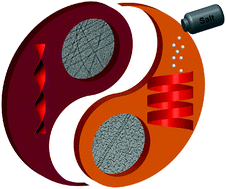A combined experimental and computational approach reveals how aromatic peptide amphiphiles self-assemble to form ion-conducting nanohelices†
Abstract
Reported here is a combined experimental–computational strategy to determine structure–property–function relationships in persistent nanohelices formed by a set of aromatic peptide amphiphile (APA) tetramers with the general structure KSXEKS, where KS = S-aroylthiooxime modified lysine, X = glutamic acid or citrulline, and E = glutamic acid. In low phosphate buffer concentrations, the APAs self-assembled into flat nanoribbons, but in high phosphate buffer concentrations they formed nanohelices with regular twisting pitches ranging from 9–31 nm. Coarse-grained molecular dynamics simulations mimicking low and high salt concentrations matched experimental observations, and analysis of simulations revealed that increasing strength of hydrophobic interactions under high salt conditions compared with low salt conditions drove intramolecular collapse of the APAs, leading to nanohelix formation. Analysis of the radial distribution functions in the final self-assembled structures led to several insights. For example, comparing distances between water beads and beads representing hydrolysable KS units in the APAs indicated that the KS units in the nanohelices should undergo hydrolysis faster than those in the nanoribbons; experimental results verified this hypothesis. Simulation results also suggested that these nanohelices might display high ionic conductivity due to closer packing of carboxylate beads in the nanohelices than in the nanoribbons. Experimental results showed no conductivity increase over baseline buffer values for unassembled APAs, a slight increase (0.4 × 102 μS cm−1) for self-assembled APAs under low salt conditions in their nanoribbon form, and a dramatic increase (8.6 × 102 μS cm−1) under high salt conditions in their nanohelix form. Remarkably, under the same salt conditions, these self-assembled nanohelices conducted ions 5–10-fold more efficiently than several charged polymers, including alginate and DNA. These results highlight how experiments and simulations can be combined to provide insight into how molecular design affects self-assembly pathways; additionally, this work highlights how this approach can lead to discovery of unexpected properties of self-assembled nanostructures.



 Please wait while we load your content...
Please wait while we load your content...
